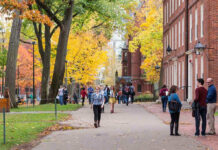
As Alan Hausman walks through the Tree of Life synagogue in Pittsburgh, he carries the invisible weight of “survivor’s remorse” from the 2018 shooting that claimed 11 lives, while the Justice Department confronts a staggering 100% increase in attacks on religious institutions nationwide between 2021 and 2023.
Key Takeaways
- Attacks on religious institutions have nearly doubled from 2021 to 2023, forcing houses of worship to implement unprecedented security measures.
- Alan Hausman, president of the Tree of Life synagogue board, continues to experience “survivor’s remorse” following the 2018 mass shooting that killed 11 people.
- The Justice Department is actively prosecuting perpetrators of religious attacks, with Assistant Attorney General Harmeet Dhillon describing these crimes as “a form of terrorism.”
- White nationalism and anti-minority sentiment are driving many attacks on religious institutions, particularly targeting synagogues and LGBTQ-friendly congregations.
- Religious institutions across America are increasingly forced to employ armed guards and sophisticated security systems to protect worshippers.
The Growing Crisis of Violence Against Houses of Worship
The alarming surge in attacks on religious institutions across America has created an atmosphere of fear in places once considered sanctuaries of peace. FBI data reveals that assaults on churches, synagogues, mosques, and other religious facilities have increased by nearly 100% from 2021 to 2023. This disturbing trend has forced congregations nationwide to implement extraordinary security measures, fundamentally changing how Americans practice their faith. The Justice Department has responded with a decisive crackdown on perpetrators, recognizing the existential threat these attacks pose to religious freedom in America.
“I think it’s a form of terrorism, because attacks on churches are meant to terrorize people. And they’re meant to deter people from going there. And so it makes everyone feel unsafe,” Harmeet Dhillon, Assistant Attorney General for Civil Rights.
Recent prosecutions demonstrate the Justice Department’s commitment to addressing this crisis. Rui Zhang received a 25-year sentence for planning an attack on a Virginia church, while Zimnako Saleh was convicted for targeting churches across multiple states. Kevin Colantonio pleaded guilty to setting fires at a predominantly black church, and Elias Rodriguez faces charges for murdering Israeli embassy officials. These cases represent just a fraction of the growing violence against religious communities that the Trump administration’s Justice Department is combating with increasing urgency.
The Lasting Trauma of the Tree of Life Massacre
For Alan Hausman, president of the Tree of Life synagogue board in Pittsburgh, the national statistics on religious violence aren’t just numbers – they’re a painful reminder of the 2018 mass shooting that forever changed his community. The attack, which claimed 11 lives in one of the deadliest acts of antisemitic violence in U.S. history, left survivors like Hausman with profound psychological wounds that reopen with each new attack on religious institutions across the country. His experience represents the human toll behind the statistics, revealing how these acts of violence create lasting trauma for entire communities.
“Every time I see another attack, it’s like someone picked the scab off of my wound,” Alan Hausman, President of the Tree of Life synagogue board.
The Tree of Life synagogue, like many religious institutions across America, has been forced to transform itself into a fortress. Armed guards now stand watch during services, sophisticated alarm systems monitor for threats, and congregants worship with a heightened awareness of potential danger. Synagogues have experienced a particularly troubling increase in vandalism and harassment, especially following events in Israel. This reality reflects a fundamental change in how Americans practice their faith – one where security concerns often overshadow the spiritual experience that brings people to houses of worship in the first place.
Understanding the Drivers of Religious Violence
The Southern Poverty Law Center has identified white nationalism as a significant factor behind many attacks on religious institutions, particularly those serving minority communities or expressing support for LGBTQ individuals. This ideological motivation transforms these attacks from isolated incidents into part of a broader pattern of targeted violence against specific religious communities. The systematic nature of these attacks underscores why the Justice Department has prioritized prosecuting them as acts of domestic terrorism rather than simply vandalism or property crimes. The pattern reveals a coordinated effort to intimidate and silence certain religious voices in America.
“We want to shut that threat down by making sure that no one feels like churches, houses of worship, or people of faith are soft targets in the United States. That is why it’s a priority,” Harmeet Dhillon, Assistant Attorney General for Civil Rights
The Justice Department’s response to this crisis has been swift and substantial. By pursuing lengthy prison terms for perpetrators of religious violence, federal prosecutors are sending a clear message that attacks on houses of worship will face severe consequences. This approach reflects the administration’s commitment to protecting religious freedom as a fundamental American right. However, the continuing rise in incidents suggests that law enforcement alone cannot solve this problem – addressing the root causes of religious hatred and extremism will require broader societal engagement and a renewed commitment to protecting America’s diverse faith communities.












